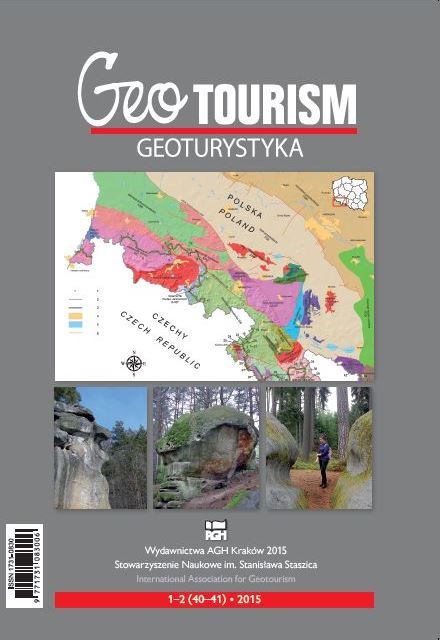Granite tors of Waldviertel (Lower Austria) as sites of geotourist interest // Granitowe skałki regionu Waldviertel (Dolna Austria) jako obiekty geoturystyczne
DOI:
https://doi.org/10.7494/geotour.2015.40-41.19Słowa kluczowe:
granite, granite geomorphology, geosites, Bohemian Massif, // granit, geomorfologia granitowa, geostanowiska, Masyw CzeskiAbstrakt
Granites of the South Bohemian Pluton are among the main rocks in the region of Waldviertel in the northern part of Lower Austria. The overall topography is gently rolling, with higher elevations and medium-altitude mountainous relief present only in the south-western part. Tors are the most characteristic residual landforms and occupy different settings, from mountain tops to valley floors. They vary in shapes and dimensions, with castle koppies and boulder clusters being most common. Many tors host well-developed microforms such as weathering pits, karren, runnels, and flared slopes. Balanced rocks are among the highlights of the region. Because of good access residual granite landforms of Waldviertel are well suited to be developed as geosites and geotourist destinations, but there is clearly a deficit of explanation and interpretation. In this paper 15 representative tors are presented, tourist infrastructure is summarized, and a thematic
one-day drive is proposed. //
Granity plutonu południowoczeskiego należą do głównych skał występujących w regionie Waldviertel w północnej części kraju związkowego Dolna Austria. Region ten odznacza się lekko falistą rzeźbą, z większymi wysokościami i górzystym ukształtowaniem jedynie w części południowo-zachodniej. Skałki stanowią najbardziej charakterystyczny element rzeźby denudacyjnej, zajmując różną pozycję morfologiczną, od szczytów wzniesień po dna dolinne. Są zróżnicowane pod względem kształtu i wymiarów, z dominacją zamczysk skalnych i zgrupowań bloków (skałek rumowiskowych). Morfologię wielu z nich urozmaicają mikroformy,
takie jak kociołki wietrzeniowe, żłobki, rynny i nisze kloszowe. Szczególnie interesującym elementem rzeźby regionu są chybotki. Dobra dostępność sprawia, że rezydualne formy granitowe regionu są odpowiednie do zagospodarowania jako geostanowiska i atrakcje geoturystyczne, choć uwagę zwraca brak szerszego
zaplecza edukacyjnego i interpretacyjnego. W artykule przedstawiono 15 reprezentatywnych skałek granitowych, podsumowano zagospodarowanie turystyczne obszaru oraz zaproponowano przebieg jednodniowej tematycznej trasy samochodowej.
##plugins.generic.usageStats.downloads##
Bibliografia
Campbell S., Gerrard A.J., Green C.P., 1998. Granite landforms and weathering products. In: Campbell S., Hunt C.O., Scourse J.D., Keen D.H. (eds), Quaternary of South-West England. Chapman and Hall, London: 73–90.
Chábera S., Huber K.H., 1995. Pilzfelsen und Wackelsteine in Granitoiden des Südböhmischen Plutons. Sborník Jihočeského muzea v Českých Budějovicích. Přírodní vědy, 35: 5–20.
Chábera S., Huber K.H., 1996. Polygonalstrukturen (polygonal cracking) auf Felsoberflächen aus Eisgarner Granit. Sborník Jihočeského muzea v Českých Budějovicích. Přírodní vědy, 36: 5–22.
Chábera S., Huber K.H., 1998. Pseudoschichtung (pseudobedding) in Granitoiden des Südböhmischen Plutons. Sborník Jihočeského muzea v Českých Budějovicích. Přírodní vědy, 38: 5–17.
Cui Z., Chen Y., Yang X., 2009. Granite landform characteristics, distribution and evolution patterns in Huangshan Mt. Chinese Science Bulletin, 2009: 1–13, doi: 10.1007/s11434-009-0309-x.
Czudek T., Demek J., Marvan P., Panoš V., Raušer J., 1964. Verwitterungsund Abtragungsformen des Granits in der Böhmischen Masse. Petermanns Geographische Mitteilungen, 108: 182–192.
Demek J., 1964. Castle koppies and tors in the Bohemian Highland (Czechoslovakia). Biuletyn Peryglacjalny, 14: 195–216.
Höck V., 1999. Der geologische Bau des Grundgebirges. In: Steininger F.F. (ed.), Erdgeschichte des Waldviertels. Waldviertler Heimatbund, Horn – Waidhofen/Thaya: 37–60.
Huber K.H., 1999. Zum Formenschatz der Granitverwitterung und -abtragung im nordwestlichen Waldviertel. In: Steininger F.F. (ed.), Erdgeschichte des Waldviertels. Waldviertler Heimatbund, Horn – Waidhofen/Thaya: 113–132.
Huber K.H., 2003. Some field observations and remarks on the Gmünd beds of the northwestern Waldviertel region (Lower Austria). Jahrbuch der geologischen Bundesanstalt, 143: 543–566.
Huber K.H., Chábera S., 1993. Nové lokality žlábkových škrapu v žulach centrálního masívu moldanubického plutonu. Sborník Jihočeského muzea v Českých Budějovicích. Přírodní vědy, 33: 5–14.
Huber K.H., Chábera S., 1994. Úpatní výklenky na žulových balvanech moldanubika. Sborník Jihočeského muzea v Českých Budějovicích. Přírodní vědy, 34: 5–16.
Hundert Meisterwerke. Die schönsten Geotope Bayerns. Bayerisches Landesamt für Umwelt, Augsburg 2012.
Jahn A., 1974. Granite tors in the Sudeten Mountains. Institute of British Geographers, Special Publication, 7: 53–61.
Koller F., 1999. Plutonische Gesteine. In: Steininger F.F. (ed.), Erdgeschichte des Waldviertels. Waldviertler Heimatbund, Horn – Waidhofen/Thaya: 25–36.
Lageat Y., 2013. The “Pink Granite” Coast (Northern Brittany). In: Fort M., André M.-F. (eds), Landscapes and Landforms of France. Springer, Dordrecht: 53–60.
Linton D.L., 1955. The problem of tors. Geographical Journal, 121: 470–487.
Migoń P., 1996. Granite landscapes of the Sudetes Mountains – some problems of interpretation: a review. Proceedings of the Geologists’ Association, 107: 25–38.
Migoń P., 2007. Sanqingshan – ukryty skarb Chin. Geoturystyka, 2(5): 33–40.
Štěpančíková P., Rowberry M., 2008. Rock landforms that reflect differential relief development in the north-eastern sector of the Rychlebské hory and the adjacent area of Žulovská pahorkatina (SE Sudeten Mts, Czech Republic). Acta Geodynamica et Geomaterialia, 5, 3 (151): 297–321.
Twidale, C.R., 1968. Origin of Wave Rock, Hyden, Western Australia. Transactions of the Royal Society of South Australia, 92: 115–123.
Twidale, C.R., 1982. Granite Landforms. Elsevier, Amsterdam.
Věžník A., 1982. Některé mezo- a mikroformy zvětrávání a odnosu žuly v Novobystřické vrchovině. Sborník Československé Společnosti Zeměpisné, 87: 13–22.
Votýpka J., 1964. Tvary zvětrávání a odnosu žuly v severní částí Novobystřické vrchoviny. Sborník Československé Společnosti Zeměpisné, 69: 243–258.
Votýpka J., 1974. Vznik a vývoj mezoreliéfu a mikroreliéfu Sedmihoří. Acta Universitatis Carolinae, Geographica, 2: 17–34.
Votýpka J., 1979. Geomorfologie granitové oblasti masívu Plechého. Acta Universitatis Carolinae, Geographica, 16(2): 55–83.
Wilhelmy H., 1958. Klimamorphologie des Massengesteine. Westermann, Braunschweig.



